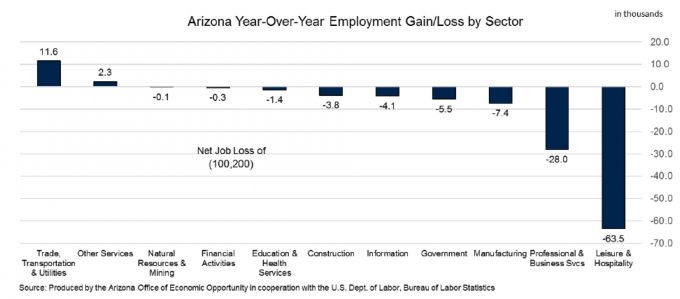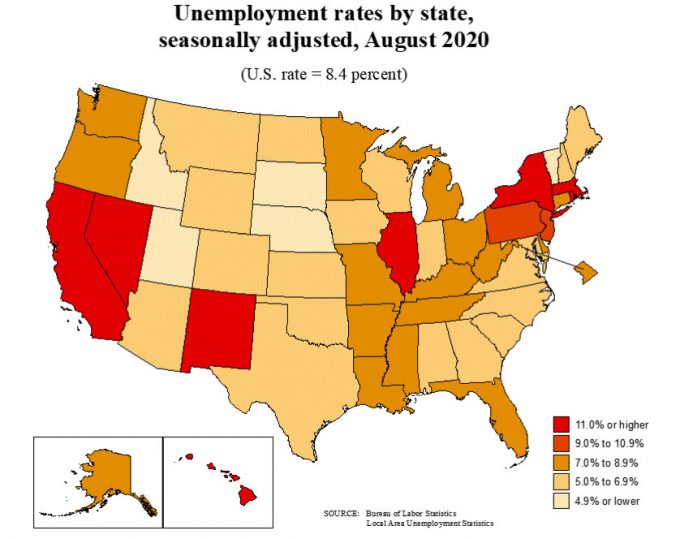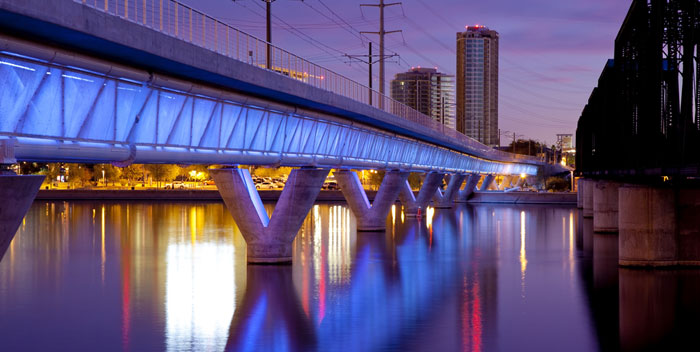by Valorie H. Rice
Senior Specialist, Business Information
Current data releases as of 18 September 2020
Employment in Arizona for August decreased 3.4 percent over-the-year before seasonal adjustment. Employment in the U.S. decreased 7.0 percent during the same time. The September 17 Arizona Office of Economic Opportunity release indicated that trade, transportation and utilities along with other services were the only two sectors to gain jobs over-the-year in August. Leisure and hospitality continued to post the largest job losses followed by professional and business services. Sierra Vista-Douglas again had year-over-year employment growth, at 4.2 percent for August, the only Arizona metropolitan area to have positive change. Flagstaff, on the other hand, sustained the most job losses at -15.5 percent. Employment changes in other Arizona metropolitan areas were Lake Havasu City-Kingman -4.4 percent, Phoenix -3.5 percent, Tucson -3.4 percent, Yuma -2.3 percent, and Prescott -0.8 percent. Arizona seasonally adjusted unemployment rate dropped to 5.9 percent in August, from 10.7 percent in July. This was not exactly good news as the drop in unemployment came from a large decrease of people dropping out of the labor force.

Arizona’s seasonally adjusted unemployment rate of 5.9 percent in August placed it among 29 states with a lower rate than the U.S. at 8.4 percent. Unemployment rates lowered in most states, rose in just two states and seven states remained the same according to the September 18 Bureau of Labor Statistics State Employment and Unemployment release. Unemployment rates for the month ranged from 4.1 percent in Utah to a high of 13.2 percent in Nevada.

U.S. nonfarm employment increased 1.4 million in August based on the Bureau of Labor Statistics September 4 Employment Situation release. Government supplied the largest amount of jobs for the month due to temporary hiring for the 2020 Census. Private sector job growth was in retail trade, professional and business services, leisure and hospitality, and education and health services. The unemployment rate was 8.4 percent for August, a drop of 1.8 percentage points from July. The employment-population ratio increased to 56.5 percent.
The U.S. trade deficit rose $10.1 billion in July to $63.6 billion. Both exports and imports were higher for the month but imports grew more, increasing $22.7 billion to $231.7 billion compared to an increase of $12.6 billion for exports placing it at $168.1 billion for July. The year-to-date deficit of goods and services was 1.8 percent higher than the same period in 2019.
The Consumer Price Index increased 0.4 percent in August on a seasonally adjusted basis, down from 0.6 percent in July. Price increases were widespread, with used car and truck prices rising the most. The energy index rose 0.9 percent while food went up 0.1 percent. The index for all items less food and energy rose 0.4 percent for the month with used cars and trucks accounting for a good portion of the increase. According to the September 11 Bureau of Labor Statistics release, the annual inflation rate for August was 1.3 percent before seasonal adjustment.
The Census Bureau released the 2019 American Community Survey (ACS) 1-year estimates on September 17. The ACS 1-year estimates provide statistics for areas with populations of 65,000 or more in over 40 demographic and economic topics including income, poverty, family characteristics and education. This year was the first time that household and family characteristics included information on same-sex couples. There were more than 980,000 households in the U.S. in 2019 comprised of same-sex couples. Of these, 58 percent were married couples and 42 percent were unmarried. Arizona had 25,298 households with same-sex couples, and at about 60 percent, a larger percentage of them were married couples compared to the U.S. Both the U.S. and Arizona had larger numbers of female same-sex households than male same-sex households. Same-sex couples made up less than one percent of all households in both Arizona and the nation.





